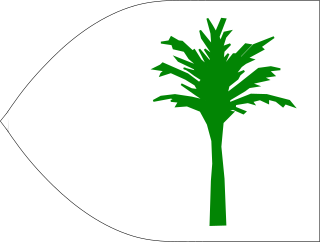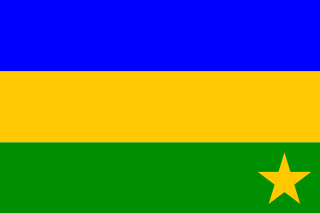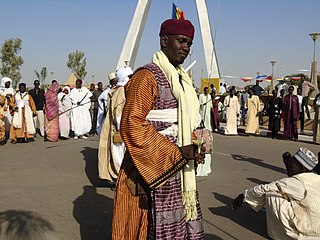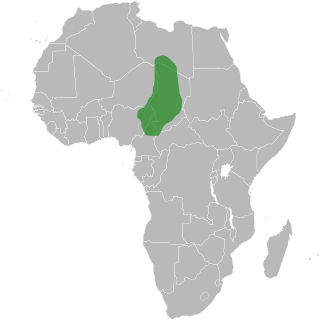
The Kanem–Bornu Empire existed in areas which are now part of Niger, Cameroon, Central African Republic, Chad, and Nigeria. It was known to the Arabian geographers as the Kanem Empire from the 8th century AD onward and lasted as the independent kingdom of Bornu until 1900.

Central Africa is a subregion of the African continent comprising various countries according to different definitions. Angola, Burundi, Cameroon, the Central African Republic, Chad, the Democratic Republic of the Congo, the Republic of the Congo, Equatorial Guinea, Gabon, Rwanda, and São Tomé and Príncipe are members of the Economic Community of Central African States (ECCAS). Six of those states are also members of the Economic and Monetary Community of Central Africa (CEMAC) and share a common currency, the Central African CFA franc.

The Kanuri people are an African ethnic group living largely in the lands of the former Kanem and Bornu Empires in Niger, Nigeria, Sudan, Libya and Cameroon. Those generally termed Kanuri include several subgroups and dialect groups, some of whom identify as distinct from the Kanuri. Most trace their origins to ruling lineages of the medieval Kanem-Bornu Empire, and its client states or provinces. In contrast to the neighboring Toubou or Zaghawa pastoralists, Kanuri groups have traditionally been sedentary, engaging in farming, fishing the Chad Basin, and engaged in trade and salt processing.
Kanem is one of three departments which make up the region of Kanem in Chad. The capital is Mao.

Kanem is one of the 23 regions of Chad. It is named after the famous Kanem Empire, which was centred in this vicinity. The region's capital is Mao. It was created in 2002 from the former Prefecture of Kanem. In 2008, a portion of the Kanem region was split off to become the new Bahr el Gazel Region.

The Kanembu are an ethnic group of Chad, generally considered the modern descendants of the Kanem-Bornu Empire. The Kanembu number an estimated 890,000 people, located primarily in Chad's Lac Prefecture but also in Chari-Baguirmi and Kanem prefectures. They speak the Kanembu language, which the Kanuri language is derived from, with many speaking Arabic and sometimes nowadays French as a second language.

Sayfawa dynasty, Sefouwa, Sefawa, or Sefuwa dynasty is the name of the Muslim kings of the Kanem–Bornu Empire, centered first in Kanem in western Chad, and then, after 1380, in Borno.
Hummay was the first Muslim king, mai, of the Sefuwa dynasty within Kanem-Bornu Empire from 1085 to 1097, replacing the Sefuwa-Duguwa dynasty.

The Bilala are a Muslim people that live around Lake Fitri, in the Batha Prefecture, in central Chad. The last Chadian census in 1993 stated that they numbered 136,629 people. Their language, Naba, is divided in four dialects and is a part of the Central Sudanic language family; it is shared by two of their neighbours, the Kuka and the Medogo. These three peoples are collectively known as Lisi and are believed to be descendants of main ethnic groups of the Sultanate of Yao.
The Buduma are an ethnic group of Chad, Cameroon, and Nigeria who inhabit many of the islands of Lake Chad. They are predominantly fishers and cattle-herders. In the past, the Buduma carried out violent raids on the cattle herds of their neighbors. They were feared villains with aggressive reputations; thus, they were respected and left alone for many years, protected by their own habitat of water and reeds.
Kanembu is a Nilo-Saharan language spoken in Chad by the Kanembu people. It is closely related to Kanuri.
Ahmad bin Furtu or Ibn Furtu was the sixteenth century grand Imam of the Bornu Empire and the chronicler of Mai Idris Alooma (1564–1596).
Sultan Biri Ibn Dunama was the son of Mai Dunama I, and Fasam from the Kayi ethnic group. Sultan Biri reigned as the king of Kanem, in the early stages of the Kanem Empire
Selma Ibn Abdullahi was a king of Kanem. His reign was turbulent as the kingdom was under attack from the Sao groups of Southern lake Chad.
Kure Gana Ibn Abdullahi was a king of Kanem. He was one of the four sons of Abdullahi who lost their lives during the battle with the southern ethnic groups of Lake Chad, sometimes called the Sao.
Kure Kura Ibn Abdullahi was a Mai of Kanem. He was killed in a battle with the Sao. He was one of the four sons of Abdullahi I killed in the Sao wars.
Idris I was a grandson of Mai Bir kachim and a descendant of Ibrahim Nikale. He established peaceful relationship with the Sao after four Kanem kings had been killed during conflicts with the Bornu indigenous ethnic groups or Sao. Idris I was a member of the Sayfawa dynasty.
The Kotoko people, also called Mser, Moria, Bara and Makari, are a Chadic ethnic group located in northern Cameroon, Chad and Nigeria. The Kotoko population is composed of approximately 90,000 people of which the majority live in Cameroon. The Kotoko form part of the Chadic people. Their mother tongue is Lagwan. Most of the Kotoko are Sunni Muslims.






